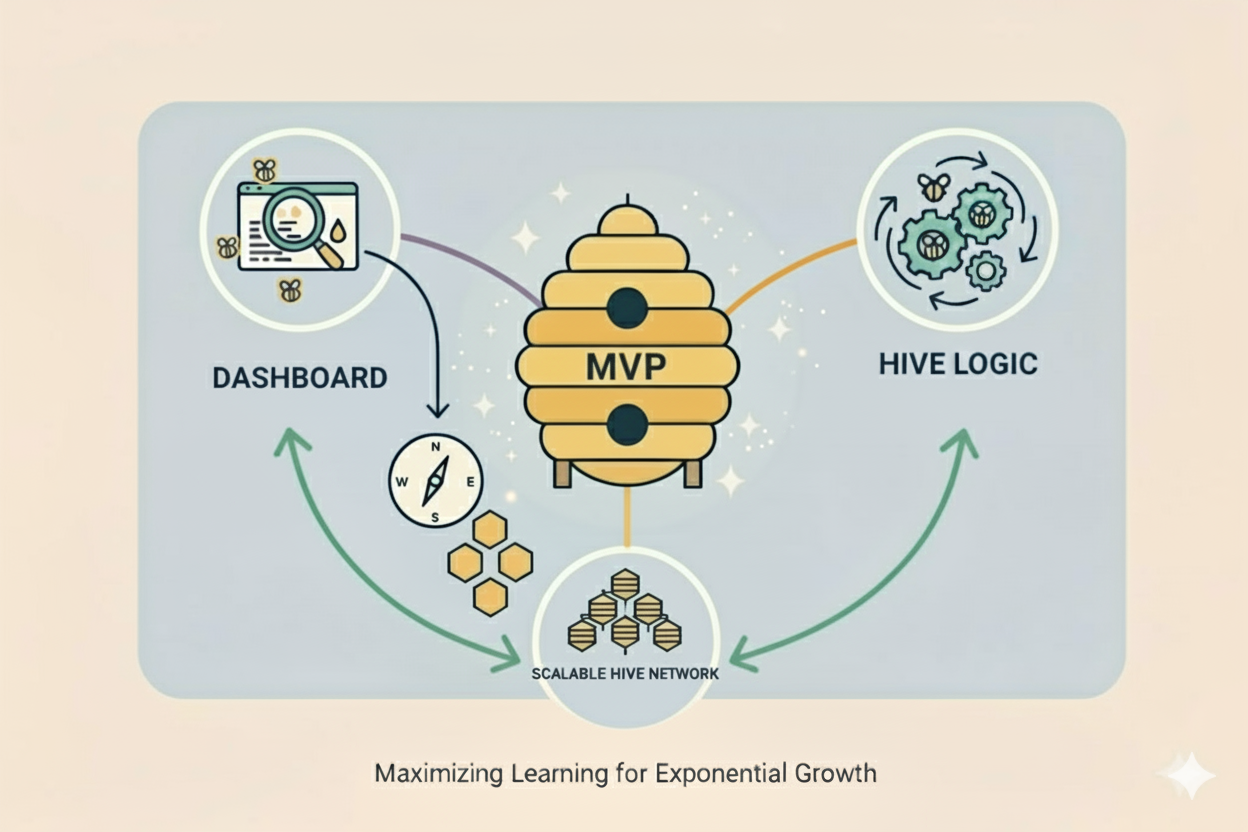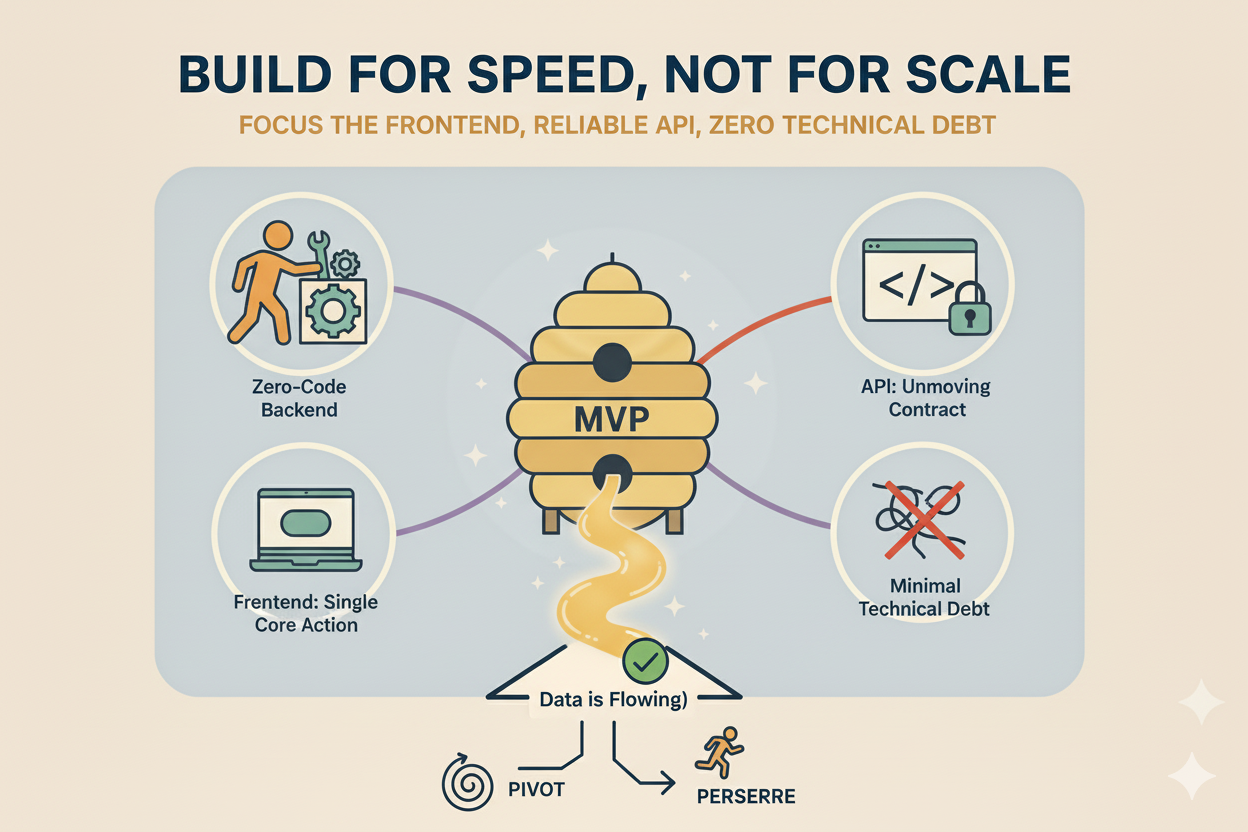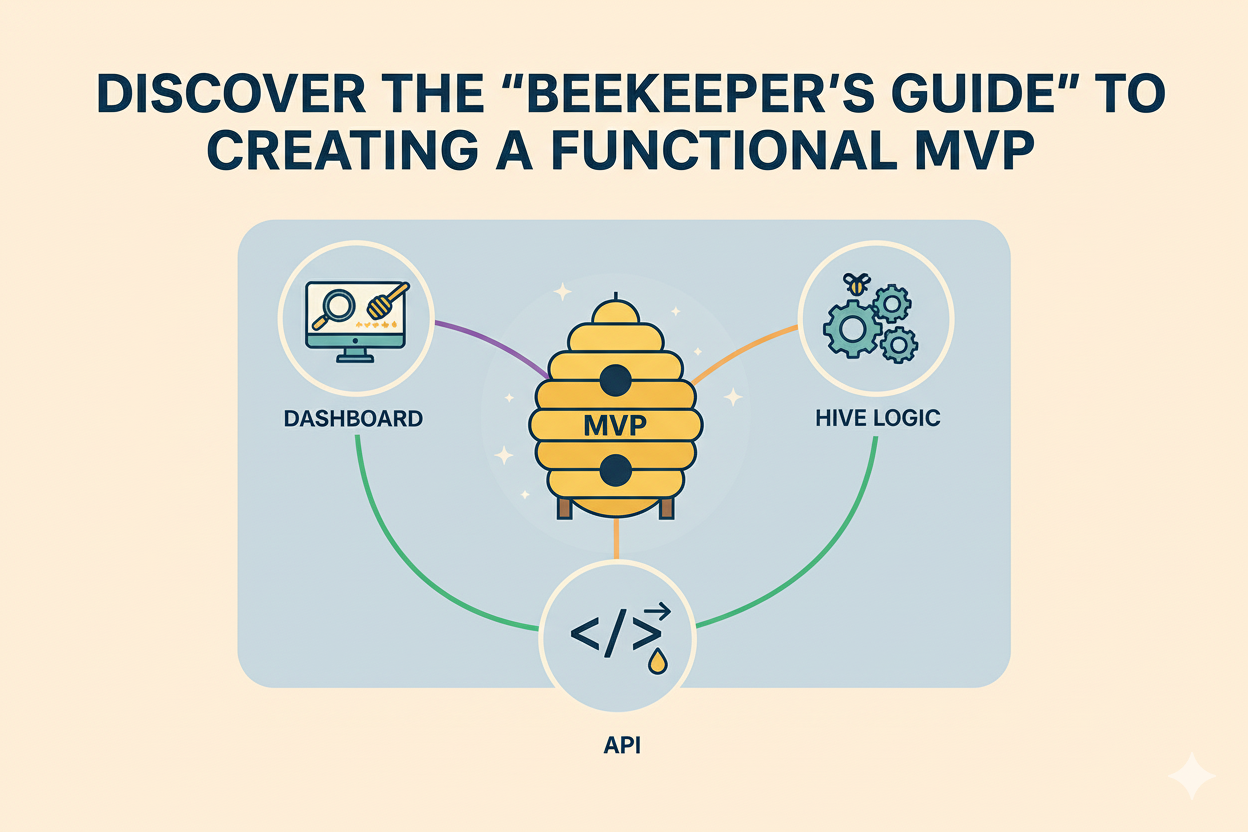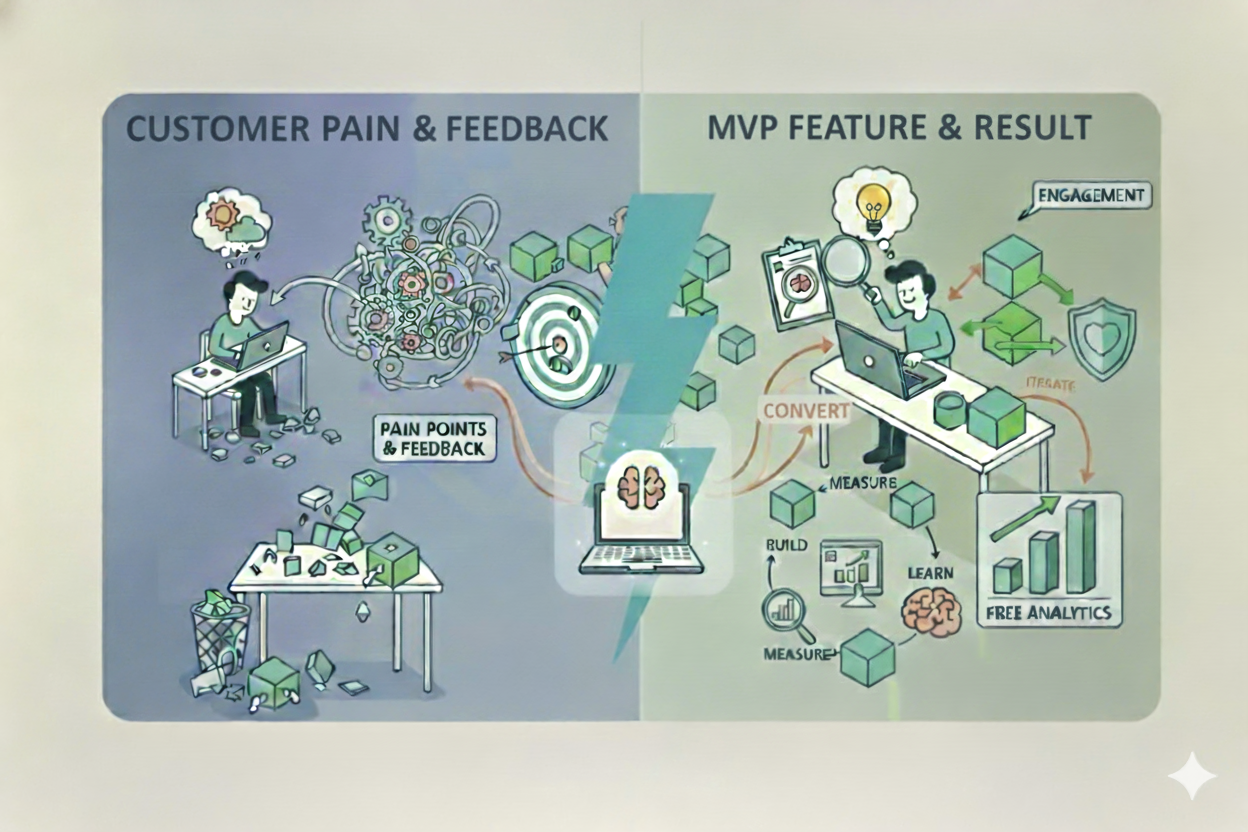The Philosophy of the Lean Build: Ruthless Minimalism
For the lean founder, the Build phase isn’t a grand architectural project; it’s a scientific experiment. It’s about setting up the smallest, smartest single hive—your Minimum Viable Product (MVP)—designed purely to test a core assumption about your market or user behavior. The build is successful not when the code is perfect, but when the product is ready to begin the Measure phase.
This approach is especially crucial for the "vibe coder," the intuitive founder who understands the market intimately but may not possess deep, professional technical expertise. For this type of founder, the primary goal is to maximize validated learning with minimal custom code. Every minute, every dollar, and every line of code spent over-engineering a non-essential feature is a minute taken away from the critical feedback loop of Measure and Learn.
The difference between a successful MVP and a failed project often comes down to this single, crucial principle: Ruthless Minimalism. You must view any component that doesn't directly contribute to testing your core hypothesis as an enemy of progress. It is an unnecessary complexity, a distraction, and a drain on your most precious resource: time. If you build it and it isn't used, you lose time; if you build it and it's used the wrong way, you must now rewrite it. The only safe way forward is to build the bare minimum.
While the Build phase can seem intimidating, especially when observing the complex, sprawling systems of established tech companies, it's not about achieving technical perfection or constructing a sprawling digital apiary. Instead, it's about generating the fastest, clearest path to validated learning. For the intuitive founder, this means assembling the smallest possible functional "hive" that can produce your first batch of "honey" (measurable customer value).
Forget spending months and a fortune coding a monolithic application. Your singular goal is to Maximize Learning Velocity. We prioritize tools and architectures that enable rapid iteration—allowing you to deploy a change in hours, not weeks—and minimize technical debt until your core hypothesis is proven worthy of scaling. The biggest mistake at this stage is over-engineering a feature that customers don't actually need, leading to the dreaded sunk cost fallacy where you become too invested to pivot.
🐝 The MVP as a Hive Analogy: The Three Essential Components
Your Minimum Viable Product (MVP) is your first, smallest hive. To be functional—to produce honey and gather data—it requires three essential, working components, like any real beehive:
The Frontend (The Dashboard): What the beekeeper (user) sees, touches, and interacts with. This is the observation deck and control panel.
The Backend (The Hive Logic): The actual system of working bees, data storage, and the Queen Bee (your core business logic). This is the machinery hidden from sight.
The API (The Hive Entrance): We'll cover this critical connection layer, the structured gateway between the front and back, in detail in Part II.
🛠️ Step 1: Designing Your Beekeeper’s Dashboard (The Frontend MVP)
The Frontend is your Beekeeper’s Dashboard—it’s the user interface and user experience (UI/UX). It is the visual reality of your product. In the Build phase, this should be a simple, legible interface that enables one core action that delivers value.
The Dashboard is where the "vibe check" happens. The interface must be perfectly tailored to the "beekeeper’s" immediate needs. If the glove doesn't fit, the beekeeper won't use the tool, regardless of how efficient the backend is. The dashboard must be simple, clean, and unambiguous.
Focus on the Single Core Action
This is the most critical design constraint. Ask yourself: What is the single action that, if the user completes it, proves my core value hypothesis?
If your product is a scheduling tool, the core action is "Booking a Time Slot," not registering an account or managing settings.
If your product is a content curator, the core action is "Saving the First Article," not customizing a profile image.
Every pixel on the screen should direct the user toward completing that one, measurable action. Anything else is noise that dilutes your testing clarity.
Lean Tools for the Dashboard: Component Thinking Deep Dive
We don't code the whole dashboard at once; we build it using reusable blocks. This concept is called Component Thinking, and it’s intuitive for non-coders because it mirrors assembling a physical kit.
The primary advantage of components is modularity and stability. If the HoneyGauge display breaks, you only look at the five lines of code in the HoneyGauge component, not the entire application. This compartmentalization drastically reduces debugging time and development anxiety for non-technical founders.
Mockups First: Before writing any code, start with simple wireframe tools (even a napkin sketch works!). Define the layout and flow. Your focus should be on how the user issues commands and views the hive status—not on fonts or color palettes.
Code-Based MVP: React: If you need a functioning prototype, React (for web applications) and its sibling React Native (for mobile apps) are the industry standard because they enforce this modularity. You break the UI into small, reusable components (e.g., a HoneyGauge display, a LogNewHarvest button, a HiveStatusCard).
Aesthetics vs. Functionality: Always prioritize clarity over flash. An ugly but perfectly usable dashboard is infinitely better than a beautiful product that confuses the user. Don't over-polish; just make it functional.
The Platform Decision: Web vs. Mobile
This decision directly impacts your Learning Velocity.
Unless your core value proposition absolutely requires native phone hardware (like accessing the camera, GPS location, or device gyroscope): start with React for the web.
| Platform | Deployment Complexity | Iteration Speed | Recommendation for MVP |
|---|---|---|---|
| Web (React) | Instant (Share a URL) | Hours (Immediate Code Updates) | Always start here. Faster, cheaper, and easier to pivot. |
| Mobile (React Native) | Weeks (App Store / Play Store Approvals) | Days (Complex Build Pipelines) | Only build here if your core hypothesis requires a native feature. |
Web deployment is faster, cheaper, and easier to iterate on. You can always transition to React Native later if validation proves a mobile app is necessary, leveraging much of the same knowledge base and JavaScript skills.
Step 2: Creating Simple Hive Logic (The Backend Prototype)
The Backend is the hidden machinery—the server processes, databases, and logic that make the hive work. It’s where all the real heavy lifting happens. For your MVP, this layer is built for simplicity and should house only the data necessary to support your single core action.
The backend consists of three interconnected elements:
The Bees (Server Processes): The actual compute power that runs code, handles security, and processes requests. These are the workers.
The Honeycombs (Databases): Where all your structured information—the user list, hive locations, and harvest history—is stored. This is your vault.
The Queen Bee (Business Logic): Your unique algorithm, pricing formula, or critical set of rules that define your product's value. This is the intellectual property.
Lean Tools for the Hive: Prioritizing Velocity
Instead of immediately committing to a complex server infrastructure, we prioritize tools that automatically provide data storage and API access, allowing you to bypass much of the complex coding and security work.
1. The Zero-Code Hive (The Spreadsheet Solution)
Tools: Google Sheets or Airtable.
How it works: This is the ultimate "fake it 'til you make it" backend. Your spreadsheet is the database (honeycomb). You structure columns for data (e.g., Hive ID, Location, Last Harvest Date). Both tools immediately generate a basic, usable API that allows your frontend to fetch and update data.
The "Wizard of Oz" Approach: This is a key MVP technique. If your core assumption is, "Users need a personalized, daily summary of their hive health," you don't need a complex algorithm (the Queen Bee logic) on day one. Your MVP can be:
A beautiful dashboard (Frontend) with an empty summary box.
A single API that asks, "Get Today's Summary."
The backend response is simply a JSON file that you, the founder, manually update every morning based on raw data you manually retrieve.
This approach lets you validate the user's need for the output before committing significant time to coding the expensive engine. If the idea fails, you lose nothing but a few hours of setup. Only once the data confirms users rely on that daily summary should you start coding the Queen Bee logic.
2. The Low-Code Hive (The Smart Start)
Tools: Supabase (PostgreSQL) or Firebase (NoSQL).
The Magic for Non-Coders: These platforms offer a huge benefit: Auto-Generated APIs. The instant you define your data structure (your tables/collections), the platform handles all the necessary API routes for reading, writing, and updating the data. You spend your time defining what data to store, not how to secure the communication pathway. They also handle built-in user sign-ups, logins, and access control for free, saving you immense security risks.
| Tool | Database Type | Best For | Typical Use Cases |
|---|---|---|---|
| Firebase | NoSQL (Document-based) | Rapid prototyping, highly flexible or nested data, real-time sync. | Chat apps, activity feeds, user preferences. |
| Supabase | PostgreSQL (Relational) | Structured business data, complex transactions, relational integrity. | E-commerce inventory, traditional user management, financial data. |
3. The Custom Hive (The Queen Bee Logic)
You only need a custom-coded backend (like Node.js/Express.js or Python/FastAPI) when your Queen Bee (business logic) is so complex, unique, or performance-critical that it cannot be handled by a low-code database function. Delay this step as long as possible.
| Framework | Core Advantage for Founders | Language |
|---|---|---|
| Node.js / Express.js | Simplicity. Allows you to use JavaScript across both the frontend and the backend, minimizing context switching. | JavaScript |
| Python / FastAPI | Power. Excellent for data science, machine learning, or complex calculations. | Python |
The Queen Bee Principle: A Single, Testable Hypothesis
Remember, your Queen Bee (main business logic) in the MVP should be a single, testable hypothesis. Don't build all the features your product will ever have; build the one feature that delivers the core value proposition.
Bad Scope: Building a complex system to manage user preferences, advanced reporting, and global inventory from day one.
Good Scope: Building only the API call that triggers your single, proprietary "Daily Yield Prediction" rule.
If you can test that one feature quickly, you’ve completed the most difficult part of the Build phase successfully, proving the existence of your Queen Bee before you invest in her castle.
We've built the Dashboard and the Logic. Now, we must connect them. Stay tuned for Part II, where we dive into the most critical layer for modularity and future scaling: the API. We'll show you how to connect your Dashboard to your Logic and cover the mindset shift required to minimize bad technical debt!




No comments yet
Be the first to share your thoughts on this article!